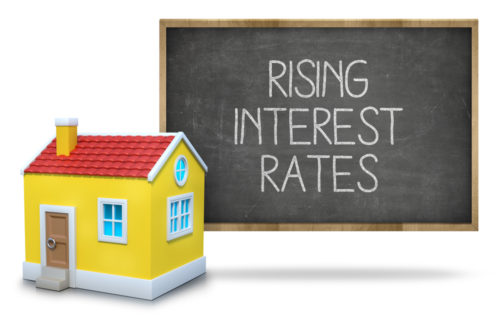One vital factor in the valuation of real estate is the prevailing interest rate. The Federal Reserve (the Fed) sets this rate and can change it to affect market changes.
Homebuyers might intuitively understand that the prevailing interest rate can affect the mortgage rate and property prices. However, they may not understand the extent of this relationship.
On the most fundamental level, the interest rate is the cost of borrowing money. If you borrow $10,000 with a 10% interest rate, you pay $1,000 in interest (if you pay back the loan in one year), and you return the $10,000. The total amount you pay is $11,000.
Interest is a form of “opportunity cost” for the lender. The lender could have put that money in another investment. However, instead of pursuing another opportunity, they are lending the money to you. In a sense, your interest payments reward them for lending to you instead of pursuing other opportunities.
Unfortunately, factors such as your wages and future plans do not figure into interest rates or home costs.
Several factors affect rates. One of the most important is the rate set by the Federal Reserve. The Fed issues Treasury Bills, or T-Bills, when they borrow money from banks. The price of these T-bills affects the rates of other lenders. For this reason, when the Federal Reserve changes interest rates, it makes the news.
But what happens to house prices when the interest rates go up or go down?
Table of Contents
What Happens to House Prices When Interest Rates Go Up?
When interest rates go up, housing prices fall.
Higher interest rates mean that it costs more to borrow the money needed to develop a property and purchase a home. Investors and developers borrow less in these conditions because they have to pay more interest on the money that they borrow. Buying a home is, likewise, more expensive because you are paying more interest on your mortgage each month.
The higher interest rates lead to less activity throughout the real estate market. Less activity means fewer people are purchasing homes. Since fewer people are interested in buying a house, there is less demand. When demand falls, home prices also decline.
The supply of new houses could eventually level off because, like individual home buyers, real estate developers do not want to pay higher interest rates on the money they need to borrow to complete their development projects. However, the supply of houses does not decrease because existing homes are still on the market. Therefore, the supply of houses will not fall as much as the demand falls.
What Happens to House Prices When Interest Rates Go Down?
When interest rates go down, housing prices eventually increase. Lower interest rates mean that money is cheaper to borrow. Since it is cheaper to get a mortgage, both home buyers and developers pay less to purchase or develop property.
This increased activity leads to more supply, as new houses get built, and more demand, as more people purchase houses because they can get a good deal on a mortgage.
Since more people want to purchase homes, sellers can ask for more money, which buyers who are competing with one another will be willing to pay.
Though there are other factors at play, the value of property rises when interest rates go lower. If you sell during a low-interest period, you can often get a higher price for your property.
Mortgage Rates Are Only One Factor Affecting Home Prices
Interest rates are an essential variable in the real estate market, but other factors can also affect home prices, mortgage rates, and the supply and demand for housing.
Many of these elements have to do with investor activity and trends within the broader economy.
The availability of homes and the amount of capital within the market can also affect home prices. If you are looking to start investing in real estate, these concepts are quite important.
Capital Flows
The term “capital flows” describes the movement of money between countries, sectors, financial institutions, and assets.
Why are capital flows important? If real estate prices are low, investors will seek to put more capital into the real estate market to take advantage of favorable conditions.
More capital flowing into the real estate market will increase demand. This dynamic, in turn, could increase the value of real estate. At the same time, capital flow into real estate can also increase supply because developers have investors who are eager to put their capital to work in favorable market conditions.
When markets are stagnant, investors may look elsewhere for investment opportunities. In these cases, the government can intervene and lower interest rates to make investment conditions more favorable again.
Supply and Demand for Capital
The supply and demand for capital fluctuates according to market conditions and interest rates. The demand for capital can increase interest rates. Home shoppers and investors are willing to pay higher interest rates to borrow money to take advantage of low home prices. Because of this extra interest, lenders can get away with charging higher rates.
As interest rates rise, however, home prices will eventually fall.
The supply of capital depends on the interest rate set by the Federal Reserve and the prices offered on interbank loans. When the supply of capital outpaces demand, then interest rates will fall. Lenders need to lower rates to get more investors and home buyers interested in borrowing this excess money.
Investors’ Required Rates of Return
Investors in the real estate and lending markets focus on the rate of return. To understand this, you need to understand two related concepts: discount rates and capitalization rates.
A discount rate is also known as the required rate of return. This term refers to the amount that the investor wants to make on the property. The discount rate needs to meet or exceed the actual rate of return. If the projected rate of return is below the discount rate, then the investor will make a profit. However, if the discount rate is lower, then the property is not a good investment.
When this dynamic occurs throughout the real estate market, lower interest rates can help investors meet their discount rate requirements. When discount rates are favorable, however, investors are willing to pay more interest to participate in the profitable market.
If real estate prices are too high (or rental prices are too low), then investors will not get their required rate of return, and they will look elsewhere for investment opportunities. In the long term, real estate prices will need to fall to meet discount rate requirements.
The capitalization rate is the yearly income from a property as a percentage of the purchase price. If you make $100,000 per year in rent from a $1,000,000 property, the capitalization rate is 10%. It would take you 10 years to earn a profit from this property.
A higher capitalization rate would make real estate investments more attractive and drive up demand, prices, and interest rates.
Image Source: https://depositphotos.com/





